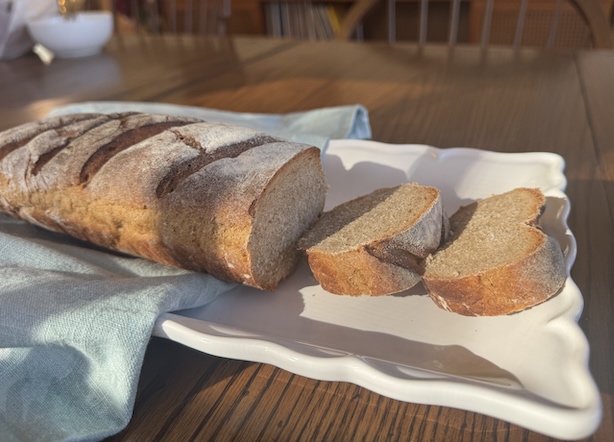Makes 2 loaves
- 1½ cups warm water
- 1 teaspoon dry yeast (half a packet)
- 2 cups unbleached flour
- 2 Tablespoons barley malt
- 1 cup wholewheat flour
- 1¾ cups rye flour
- 1 teaspoon salt
- unbleached flour for dusting
Special equipment
- baguette loaf pan
wax paper
Method
- Mix together the first four ingredients and let them sit for a few minutes. Add remaining flours and salt, then knead. Let the dough rise in a warm place for 45 minutes. Punch down. Let the dough rise again for about half an hour and then divide the dough in half. Roll out each half into a flat square on wax paper generously dusted with flour. Fold the sides to the center, squash gently, and fold in again. Pinch the seams together, bring the ends up and pinch so that no seam will show when you flip them over. Place the loaves seamside down onto the curved baking pan, and gash the loaves very deeply with a sharp knife. Let rise at least 20 minutes while your oven preheats to 450°, place the loaves seamside down onto the curved baking pan, and gash the loaves very deeply with a sharp knife. Bake for 30 minutes or to your preferred level of darkness.
Notes
- Rye bread is typical of the north and east as barley bread is typical west county fare.
The preference for white over brown breads is not recent; by the beginning of the 17th century, even the poor had abandoned their native breads for haughty white loaves, but writers commented on the trend already in the 14th century (see Wilson). London separated bread-baking into two guilds: the white bakers and the tourte or brown bakers, who were forbidden to bake white bread or even to possess bolters for sifting the flour (Wilson again).
Suggestions
- This makes two very moist, heavy loaves of about a full pound each. You can make a fully wholemeal version by substituting wholewheat flour for the unbleached flour in the sponge, but then you should increase the water to two cups.

